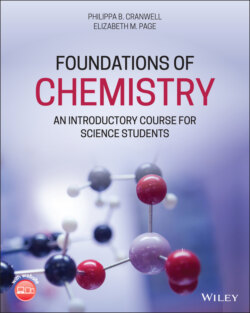Читать книгу Foundations of Chemistry - Philippa B. Cranwell - Страница 46
Quick‐check summary
ОглавлениеThe measurement system used in chemistry is the SI system. There are six base units commonly used in chemistry. All units used in chemistry can be reduced to these six base units.
Very large or very small numbers used in chemistry are expressed using scientific notation. In scientific notation, a number is expressed as a coefficient (a number between 1 and 10) multiplied by an exponential factor (10 raised to a whole number power). For numbers less than 1, the power is a negative number; and for numbers greater than 1, the power is a positive number.
Metric prefixes can be used with units to indicate multiples of 10. These prefixes are letters that denote the factor used to multiply the unit.
The properties of mass and volume are met very often in chemistry. The mass of an object is a measure of the amount of matter in the object. The volume of an object is a measure of the amount of space occupied by a substance. The litre (L) and millilitre (mL) are often used to denote volume, although these are not standard SI units.
The number of significant figures in a measurement controls the number of significant figures obtained in any calculation involving that measured quantity. The number of significant figures in the result of a calculation cannot be expressed with a greater number of significant figures than that of the smallest number of significant figures in the measured quantity.
When adding and subtracting values written using scientific notation, all exponents should be converted to the same size.
When multiplying numbers written using scientific notation, the exponents should be added. When dividing numbers written using scientific notation, the exponents in the denominator should be subtracted.
The chemical formula of a substance expresses the number of each type of atom in the substance.
Ions are single atoms or groups of atoms that have a small whole number positive or negative charge. Positive ions are called cations, and negative ions are called anions. Cations and anions combine to form salts. The overall charge on the formula unit of a salt is zero.
A chemical equation provides a shorthand method for describing the process taking place in a chemical reaction. The number and types of each atom on the left‐hand side of a chemical equation must be the same as the number and types of each atom on the right‐hand side of the equation. When this is the case, the equation is said to be balanced.
The physical state of a material at the temperature of the reaction can be included in a chemical equation using a symbol in parentheses following the formula of the substance in the equation.
